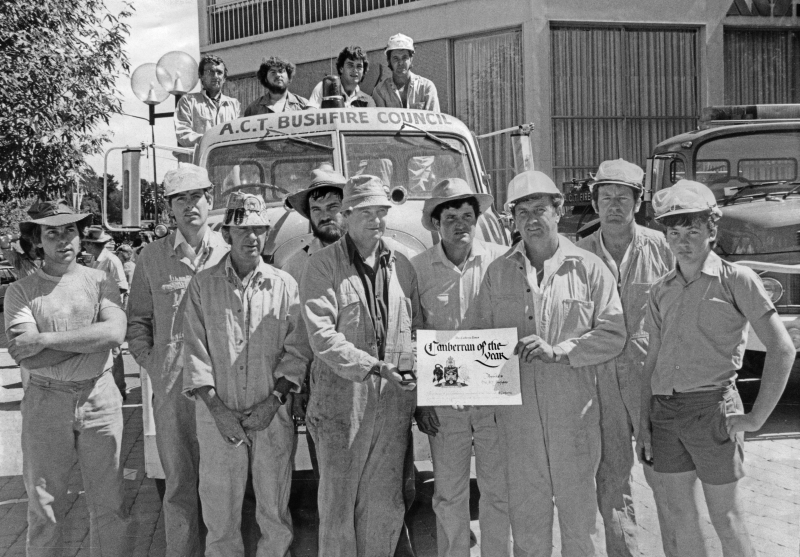Canberra Citizen of the Year
1985
The ACT Fire Fighter

SOURCE: The Canberra Times, 13 March, page 7
Long before European settlement Canberra's grassy plains were shaped by fire. Careful burning in a mosaic pattern, season by season, kept the landscape like an open park that was ideal for kangaroo hunting. It was also excellent grazing country for sheep, but with the changed use of the land fire became a threat rather than a tool.
At the turn of the twentieth century individual and neighbourly efforts to protect property from fire were clearly not enough, and in 1905 a public meeting was called to discuss bushfire prevention and suppression. A committee was formed to decide the location of firebreaks and call meetings as required.
After the establishment of the Federal Capital Territory more formal arrangements were put in place. In October 1915 the Federal Territory Bush Fire Association was created. Fire districts were mapped out, putting landholders under District Executive Officers and the three 'official sections' under the control of the Chief Inspector, Lands and Survey Branch. The Royal Military College managed its own district. The Department of Home Affairs supplied equipment to the various depots. Most District Officers had telephones; boundary riders passed messages around the crews. Queanbeyan Fire Brigade agreed to assist at any outbreak outside the town limits.
In November 1926 the Bush Fire Organisation was formed, under the control of the Lands Department of the Federal Capital Commission. Severe bushfires in January 1939 were the subject of an enquiry; among the recommendations implemented was a permanent Bush Fire Council to organise the prevention and suppression of bushfires in the ACT.
Early in the 1984-85 bushfire season the ACT Volunteer Brigades Association held their inaugural meeting at Forestry House, Yarralumla. Six brigades represented Majura, Fairlight, Hall, Williamsdale, Tidbinbilla and Tharwa/Naas. Theirs was literally a baptism of fire.
The 1984-85 fire season proved to be the worst to date. The relatively wet winter and spring resulted in heavy growth of all vegetation but particularly of grass; when followed by a hot dry summer the potential for both grass and bush fires was extreme. Although most of the 186 fires were quickly contained, several burned out of control. There were extensive fires on Mount Ainslie, Black Mountain, Mount Majura, Mount Taylor and Red Hill, and fires encroached on Holt, Tharwa and the Sundown Drive-in. Three burned out of control into New South Wales, causing the death of a NSW Volunteer fire fighter. By the end of the season 10,000 hectares of pasture and bushland in the ACT had been burned out, and a further 18,000 hectares in NSW, and 7,000 head of stock had perished.
Those fighting the fires were drawn from every professional and volunteer organisation in the ACT, including units within government departments such as Parks and Conservation, CSIRO, the Royal Military College and the Defence Forces and many individuals. The ACT Fire Brigade was heavily involved on two fronts – while assisting with the bushfires, fires from gas leaks and other causes kept them busy in town, the most spectacular being a fire in the roof of the National Library that threatened to destroy both the building and its contents.
As Canberra Day approached, the panel of judges believed that the most appropriate recipient of the Canberran of the Year Award was this entire group, to be represented by a single, unnamed fire fighter who would step forward to receive the official medallion. The ceremony took place in Petrie Plaza in Civic, still smoky but packed with grateful Canberrans.
The award attracted considerable attention, and copies of the certificate and medallion were obtained and issued to all ACT fire fighters. Although not officially part of the group, the backup staff and radio controllers were recognised for their essential but generally unseen role, as were the wives and families of the fire fighters who kept the front line supplied with food and moral support.
The fires began again a week later, in a season not surpassed for ferocity until 2003.
Select Bibliography
A history of bushfires in the ACT, viewed 27 January 2016, http://pandora.nla.gov.au/pan/10100/20140731-0000/www.firebreak.com.au/actbushfire-organisations.html
1985 'Firefighters win Canberran award.', The Canberra Times (ACT : 1926 - 1995), 12 March, p. 1, viewed 20 December, 2015, http://nla.gov.au/nla.news-article122502624
1985 'CANBERRAN OF THE YEAR.', The Canberra Times (ACT : 1926 - 1995), 13 March, p. 7, viewed 20 December, 2015, http://nla.gov.au/nla.news-article122502880
1985 ACT Bush Fire Council Annual Report 1984-85
1986 ACT Fire Brigade Annual Report 1984/85 – 1985/86

